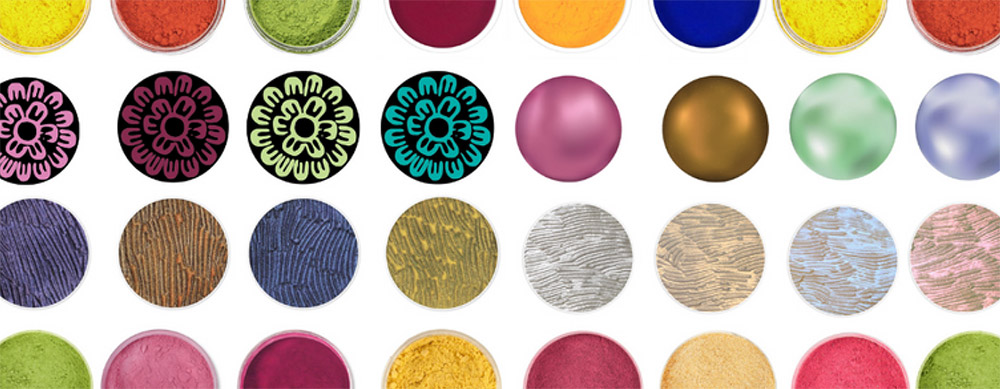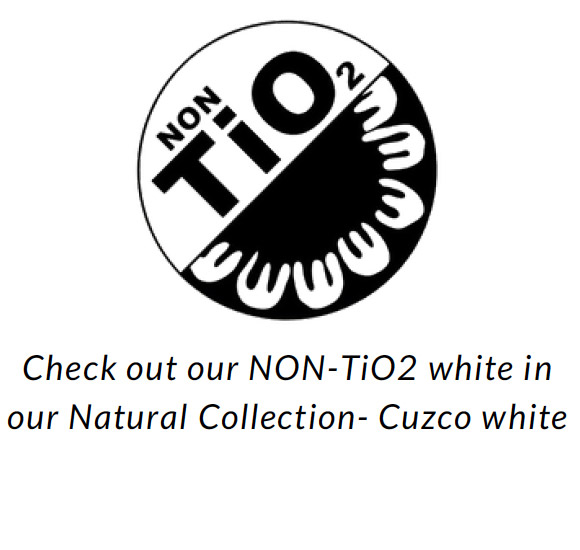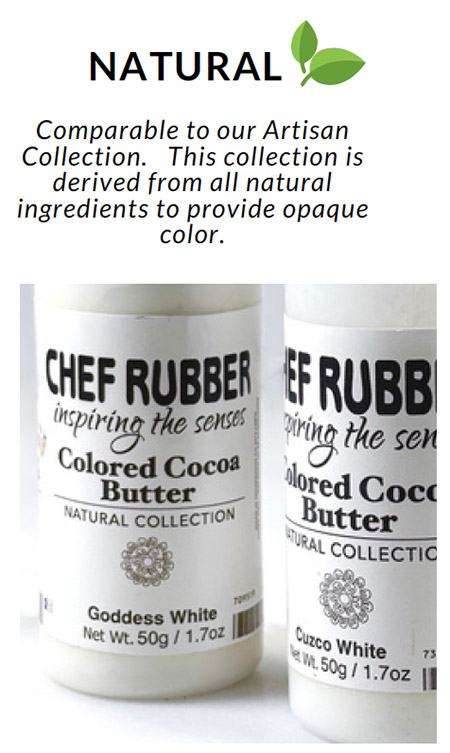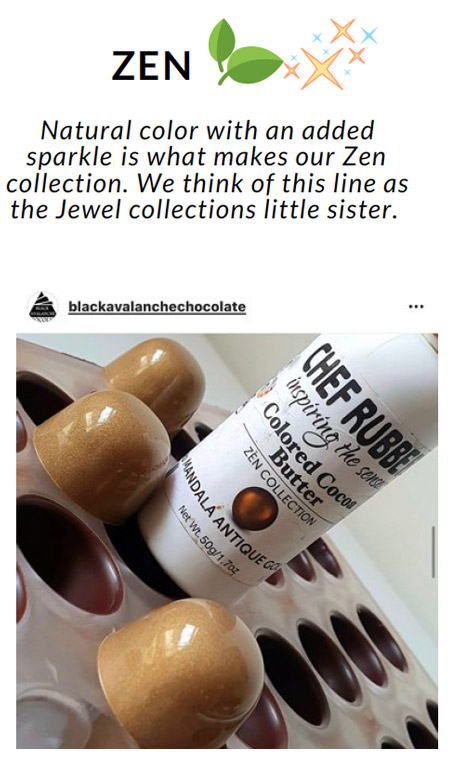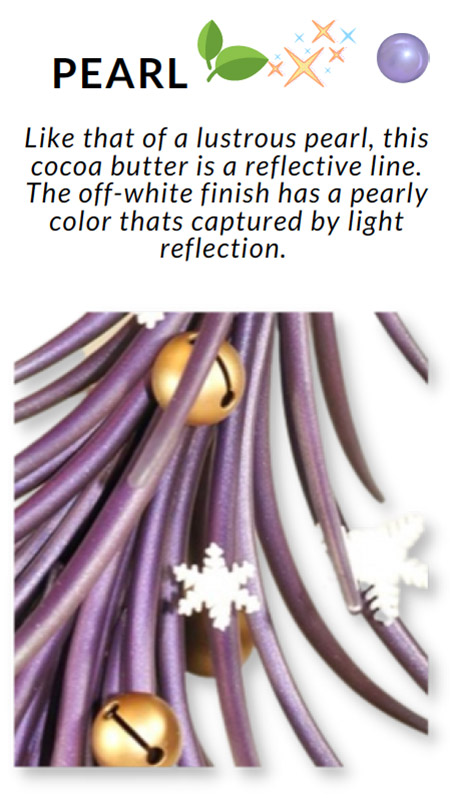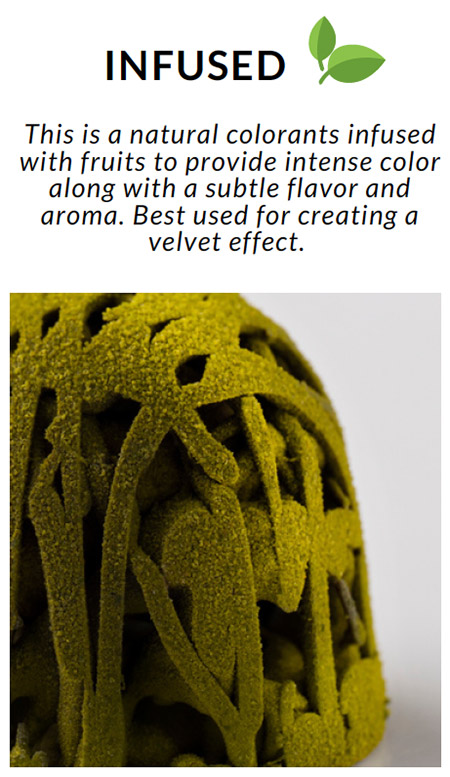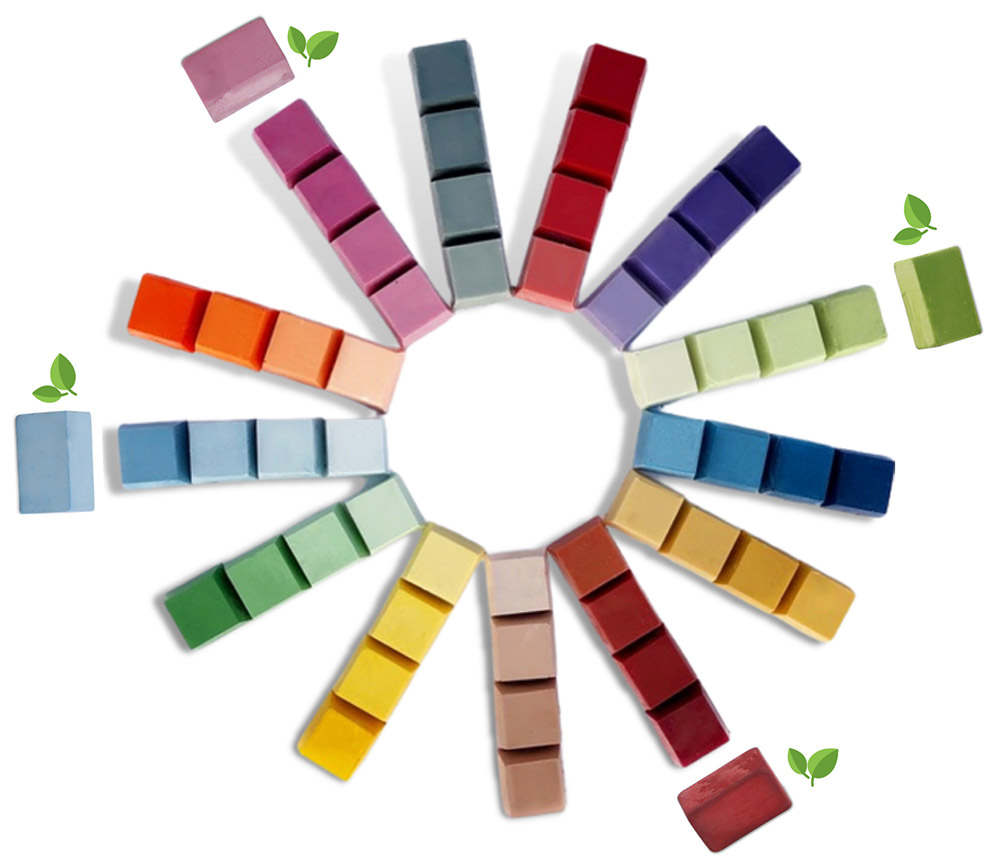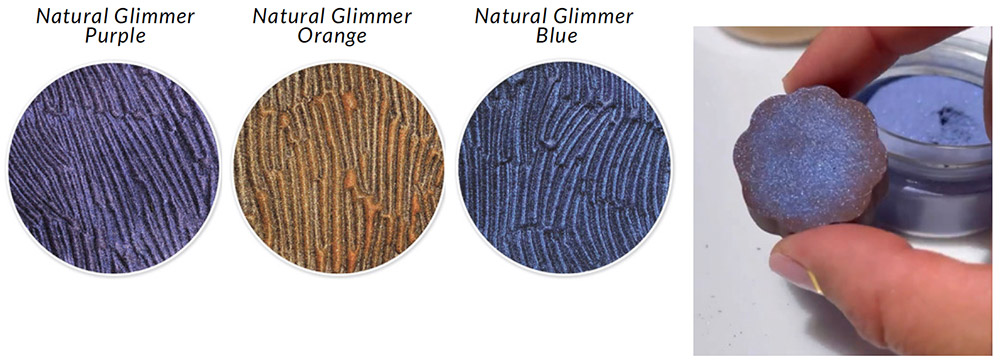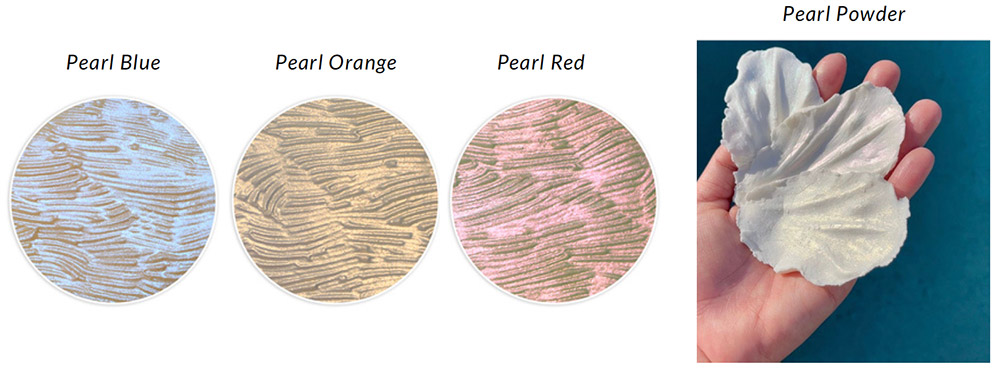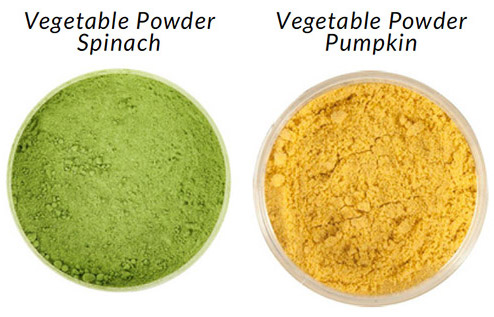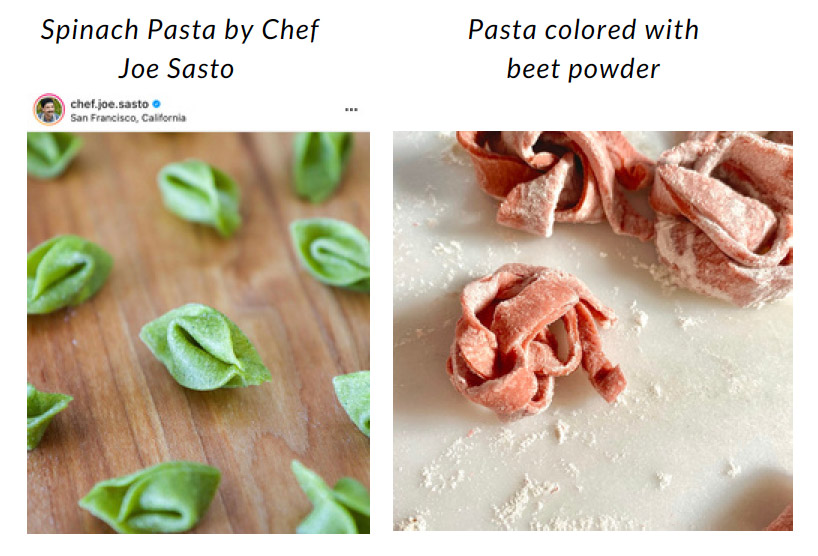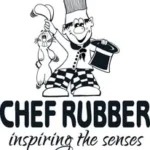NATURAL COLORS
12/28/2021
For centuries we have been using natural resources as a way to enhance the appearance of different products like food items, cosmetic products, even clothing. You may be wondering, what makes a color natural? Follow along with us as we see what makes up natural colorants, and how they influence the Chef Rubber Natural Color Lines.
NATURAL PIGMENTS: WHERE DO THEY COME FROM?
For centuries we have been using natural resources as a way to enhance the appearance of different products like food items, cosmetic products, and clothing. You may be wondering, what makes a colorant natural? Keep reading to learn about the 4 main groups of where natural pigments are derived from:
Carotenoid- Carotenoids are what gives fruits and vegetables like sweet potatoes and pumpkins their color. Pigments like red, yellow and orange are made with carotenoids.
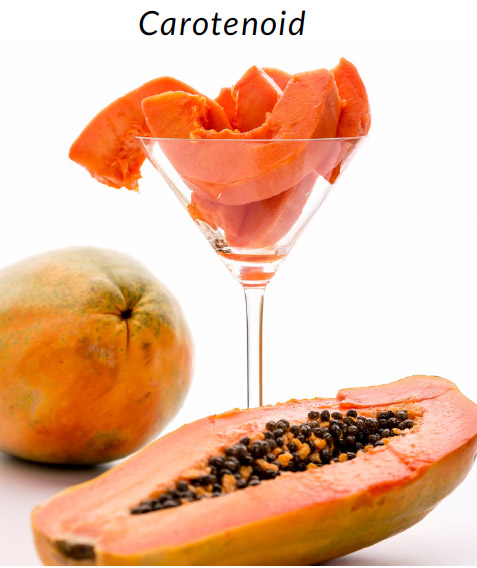
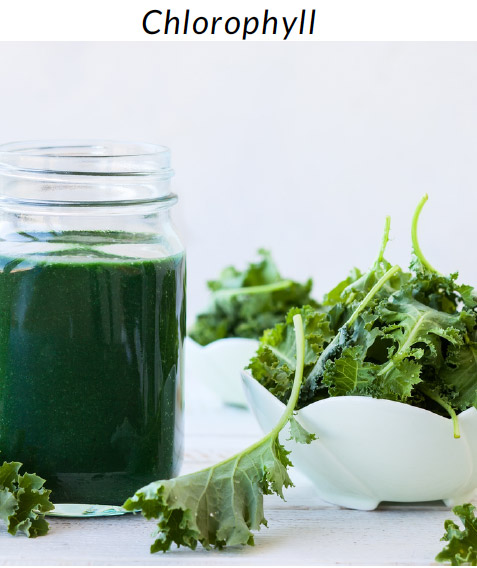
Chlorophyll- A naturally occurring pigment that is found in all green plants. Most known as green.
Anthocyanin- This is where purple and blue are derived from. Foods like grapes, blueberries and even cranberries have this pigment in them and that’s how these foods get such a deep and rich hue.
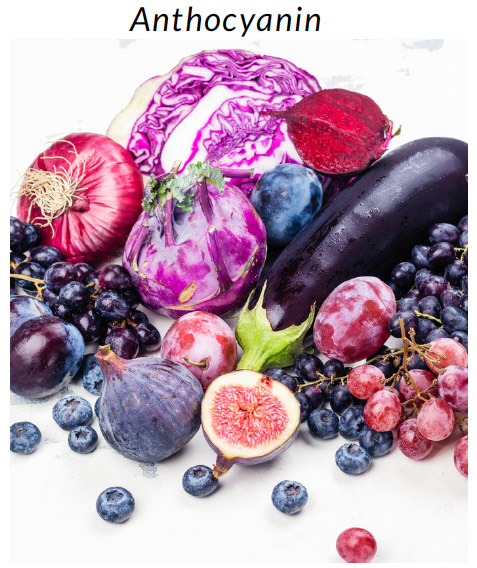

Curcumin- Also known as turmeric- it’s not only a root of the curcuma longa plant, but it’s also a rich pigment for achieving a deep yellow.
WHAT’S NATURAL AT CHEF RUBBER?
Chef Rubber food colors are available in multiple forms – from powder, to liquid, gel and paste. Which to choose will depend on the dessert, confection or beverage that is being created. The two main categories in colors for the food industry are water soluble and fat dispersible (lakes and dyes).
What does that mean?
A water-soluble colorant works best when the water content in the recipe is higher than the fat content. The best example would be when making macaron batter – the most common selection isa gel or water-based powder color that is easily mixed with the water content in the egg whites. Similarly, a fat dispersible color added to a fat-bases product like chocolate will work significantly better than adding a water-soluble colorant.

The creative mind and pastry knowledge of the Chef Rubber founders have developed and launched a full line of natural colorants. These products are derived from vegetables, fruits, herbs and spices. Chef Rubber has natural options in both water-based and fat-based colorants. Follow us down the rabbit hole as we take a deep look at the world of natural color!
FUN FACTS ABOUT FOOD COLOR:
- Yellow and Red combined make you hungry.
- Provide decorative and artistic freedoms
- Colors can trick you into tasting things that aren’t there.
TIPS FOR USING NATURAL COLORANTS:
- Back natural colors with white to really make colors pop.
- Allow time for natural pigment to develop
- Keep colors out of direct light, to help with fading.
NATURAL FAT SOLUBLE COLORANTS
NATURAL FAT BASED POWDERS (Oil- Soluble)
Creating powdered pigment is the base for all natural food color. This line of fat dispersible powders are derived from natural sources like plants, fruits and vegetables to achieve their color. Liposoluble powders disperse into fat-based contents like cocoa butter, butter, and cream. These powders are opaque and can be used to add direct color by petal dusting, or painting. Fat-based confections that use these powders include chocolate, butter cream, fondant (as a dry application), cookies, cake batters, even ice cream!
NATURAL COLORED COCOA BUTTER
Many may not know this, but our natural cocoa butter collection has been around since the early Chef Rubber years. Starting with our Natural and Pearl collections, then recently we’ve released our two newest lines- Zen and Infused. Each of these collections are derived from all-natural ingredients; plants, herbs, vegetables, and any other sources that are naturally occurring to create pigment. Currently we offer 4 lines of natural cocoa butter colors, each unique in their own way. Read on to find out more.
COLOR BRIX
In our natural fat based colors we have one other au natural alternative for your white chocolate- Color Brix! These squares are a compound of our naturally derived powdered color and small amount of cocoa butter.
These are so easy to use too! Shave, cut, or break your desired amount (or use the whole thing) and add into melted white chocolate. Stir and watch as your white chocolate turns into a vibrant color. Currently we offer 4 natural pigments red, pink, blue and green.
Note: these are ideal for smaller batches of chocolate! If you need to color more than 2 kg we suggest using colored cocoa butter or powder color.
NATURAL WATER SOLUBLE
NATURAL WATER BASED POWDERS (Water-Soluble)
Water soluble powders are colorants that are activated when used in water based recipes. This line of color will add bright color from just a speck of powder. Water soluble powders are best used to color fondant, macaron batters, royal icing, sugar work and candies. We do recommend with this line that you allow your colors to open up fully by dissolving in some water or other liquid content of your recipe.
Note: PH balance of your recipe is a factor for water based colors. When working with natural colors results of pigments may vary and some R&D may be needed before coloring large batches.

FINISHING TOUCHES
While décor powders have long been used for adding show stopping shimmer and sparkle to sculptures and display pieces- we knew that we needed to create a natural alternative that will let your products shine. Natural Glimmer & Pearl Powders can be used to dry dust with a brush, on any finished piece like, sugar cookies, chocolate pieces, modeling chocolate, fondant, etc. These powders can also be mixed with alcohol solution to paint!
Natural Glimmer Powder:
Glimmer Powders, not only add color they add a dazzling shimmer that can be used dry on chocolates, or mix with an alcohol solution to paint or airbrush onto fondant and sugar sculptures.We took our Glimmer Powder line and converted it to a natural alternative with the color being derived from nature to get its color, and mica for that highlighting shimmer we all can’t get enough of.
Pearl Powders Are Natural:
Did you know that our Pearl Powder has been a long-standing natural shimmer powder? Mica has been a natural-occurring mineral that can be found across the globe, which is what makes up our luminescent line of pearl powders. On the surface pearl powders look white, but once dusted or painted onto its product you’ll see reflective highlight of iridescent colors like that of an oyster’s pearl.
FREEZE DRIED POWDERS FOR COLOR?
As we’ve mentioned before, natural colors are derivatives from fruits and vegetables; so it only makes sense that our freeze dried fruits, juice powders, and vegetable powders can be used to add pigment to your sweet and savory creations. Not only will these powders be used to impart delicious flavor, they also give a vibrant color!
These powders having been freeze dried and then ground into a powder they can be used for a multitude of applications for a natural color, like cake batters and frostings. Other applications can use these powders for molecular gastronomy. Create colorful molecular foams with fruit and juice powders. Even vegetable powders can be used in caviar spherification to create a burst of flavor and a natural color to your culinary experience.
Quick Tip: Allow your fruit and vegetable powders to rest in your recipe or reconstitute in the liquid of your recipe for the color to really develop.
What about adding color to doughs?
If we had to guess what our most popular vegetable powders for adding color to bread and pasta dough are, it’s Beet and Spinach powders. These powders can be used dry and dusted onto bread dough before scoring, or kneaded into your bread and pasta to create a rich colorful loaf or noodles.
Vegetable powders do an excellent job withstanding high heat without turning brown. Now that’s not to say that this can’t happen especially the outer layer of breads, but this is very dependent on the conditions of baking (temp and time).
CHEF RUBBER ON INSTAGRAM


